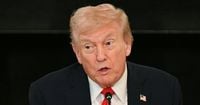The standoff over whether the United States will supply Ukraine with Tomahawk cruise missiles has escalated dramatically, with Moscow issuing blunt threats and Washington weighing the potential for a new phase in the ongoing conflict. As President Donald Trump edges closer to a decision that could reshape the battlefield—and international relations—the world is watching with bated breath.
On October 8, 2025, Andrei Kartapolov, the head of the Russian parliament’s defense committee and a former deputy defense minister, delivered a stark warning: Russia would shoot down any U.S.-supplied Tomahawk cruise missiles and destroy their launch sites if they were sent to Ukraine. Kartapolov, speaking to state media and cited by Reuters and other outlets, didn’t mince words. "Our response will be tough, ambiguous, measured, and asymmetrical," he told the RIA news agency. "We will find ways to hurt those who cause us trouble."
Kartapolov’s confidence stems from Russia’s previous encounters with Tomahawk missiles during operations in Syria. "We know these missiles very well, how they fly, how to shoot them down; we worked with them in Syria, so there is nothing new," he said, according to The New York Post. But the lawmaker also issued a direct threat to Washington and Kyiv: "The only problems will be for those who supply them and those who use them; that’s where the problems will be."
The Tomahawk is a long-range, precision-strike weapon that could enable Ukraine to hit strategic targets deep within Russian-occupied territory. Experts cited by The New York Post and Neatkarīgā note that these missiles have the power and range to decimate Russian oil refineries, weapon depots, and transportation sites far behind the front lines—capabilities Ukraine currently lacks. As one senior congressional aide put it, "Sending even a single Tomahawk to Ukraine would scare the s–t out of the Russians more than almost anything else we could do."
President Trump, for his part, has kept his cards close to his chest. On October 6, 2025, he told reporters, "I sort of made a decision, pretty much, if you consider... I think I want to find out what they’re doing with them. You know, where are they sending them? I guess I’d have to ask that question." According to Radio Kommersant FM, some analysts believe Trump’s statements are more political theater than genuine indecision. "It’s highly likely that the objectives have long been agreed upon and that all justifications for them have already been obtained. So Trump's statements are purely political and mean that Washington is ready for a new level of escalation," the outlet commented.
The potential transfer of Tomahawk missiles is not just a military issue; it’s a geopolitical flashpoint. Russian Deputy Foreign Minister Sergei Ryabkov called the possible supply a "serious escalatory step," as reported by Reuters and The Mirror. Ryabkov lamented that the "momentum" generated by President Putin and President Trump’s meeting in Alaska back in August had evaporated, blaming the "destructive actions" of European allies. "I hope that those who are pushing Washington toward such decisions fully understand the gravity and depth of the potential consequences. We, of course, call on the U.S. leadership and the American military to approach this situation soberly, sensibly, and responsibly," Ryabkov urged.
Meanwhile, the U.S. is currently only providing intelligence to Ukraine for strikes limited to Moscow’s energy sector, according to The New York Post. But analysts say Kyiv is eager for more. As Neatkarīgā explains, "In the current phase of the war missiles have become increasingly important, but Russia has many while Ukraine has few. In order to fight the enemy on halfway equal terms, Ukraine needs more modern missiles. ... The Tomahawks would allow it to launch significant strikes on Russian military infrastructure, such as bases and logistics centres located far behind the front lines and beyond the reach of Ukraine's current weapons."
Yet, with the possibility of Tomahawks entering the mix, Russia is signaling it will not stand idly by. Kartapolov downplayed the idea that the missiles would be a game-changer, claiming they could only be supplied "in tens rather than hundreds" due to Ukraine’s lack of infrastructure. But his threats were unequivocal: Russia would not only intercept the missiles but also strike at the launchers, raising the specter of escalation beyond Ukraine’s borders.
The backdrop to this high-stakes drama is Russia’s ongoing campaign of long-range attacks against Ukraine. On the same day as Kartapolov’s warning, Russian forces seriously damaged one of Ukraine’s thermal power plants in an overnight attack, injuring two workers, according to DTEK, Ukraine’s largest electricity operator. The incident underscores the vulnerability of Ukraine’s critical infrastructure as winter approaches—a vulnerability that new missile systems could, in theory, help to mitigate.
President Putin, meanwhile, has embarked on a three-day state visit to Tajikistan, meeting with leaders from other former Soviet republics. Yet, even as he marks his 73rd birthday abroad, calls for accountability follow him. Human Rights Watch has renewed its plea for Tajikistan to arrest Putin under the 2023 International Criminal Court warrant for war crimes, warning that failure to do so would show "utter disregard for the suffering of victims of Russian forces’ crimes in Ukraine."
For Ukraine, the stakes could hardly be higher. As 24tv.ua observed, "If we really get these cruise missiles, we need to be ready and understand what they can do and why the Russians are so afraid of them. And this has been the case for generations, because Tomahawks were already feared when Putin was still a low-level official in the Soviet KGB." The symbolism of Tomahawk missiles—long a source of anxiety for Moscow—adds a psychological dimension to the already fraught military calculus.
Washington now faces a difficult choice. Delivering Tomahawk missiles could give Kyiv a new edge and signal Western resolve, but it also risks a sharp Russian response—militarily, diplomatically, or even through asymmetric means like cyberattacks or disinformation. Conversely, holding back might avoid immediate escalation but could weaken Ukraine’s position and embolden Moscow.
As internal U.S. deliberations continue and NATO allies voice both support and concern, the coming weeks will test whether diplomacy can stave off a new escalation spiral. The world waits to see whether President Trump’s "sort of made a decision" becomes a decisive move that alters the course of the war—or a moment that passes without action, leaving the balance of power unchanged.
Whatever happens, the prospect of Tomahawk missiles in Ukraine has already sent shockwaves through capitals from Moscow to Washington, underscoring just how precarious and interconnected today’s security landscape has become.





